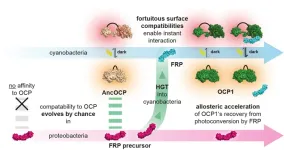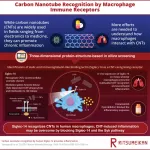(Press-News.org) Firearm injury is now the leading cause of death among U.S. children and adolescents. As its toll grows, researchers have focused on stopping violence in the moments before it happens. But new research led by the University of Washington suggests that interventions made earlier in young people’s lives may reduce the chances of it happening at all.
The study, published April 6 in JAMA Network Open, found that UW’s Communities That Care (CTC) prevention system reduced handgun carrying among adolescents growing up in rural areas. By the 12th grade, adolescents in CTC communities were 24% less likely to report carrying a handgun than those in communities without the program. Previous research has shown that handgun carrying is an important risk factor for firearm injury and harm.
“This provides yet another piece of evidence that science-based prevention systems such as CTC are worth further investments and scaling up, in different communities,” said Ali Rowhani-Rahbar, UW professor of epidemiology and Interim Director of the UW’s Firearm Injury & Policy Research Program. “Findings of this study suggest that community-based, science-based, upstream interventions focused on risk and protective factors early in life may play an important role in reducing firearm-related harm.”
The study surveyed more than 4,000 adolescents across 24 rural communities, 12 of which implemented a coordinated set of preventive interventions tailored to local priorities. Each year from 6th to 12th grade, researchers asked students about a wide range of behaviors, including whether they’d carried a handgun in the past year.
Adolescents in communities that implemented CTC were also 27% less likely to report carrying a handgun in a given grade than those in control communities.
Those findings, Rowhani-Rahbar said, merit deeper research into whether reduced handgun carrying in adolescence leads to a reduced risk of firearm-related violence throughout a person’s life. That’s especially true in rural areas, where the context around firearms may be different than in urban settings.
Rowhani-Rahbar and his team have produced a string of studies on firearm use among adolescents growing up in rural areas. A previous paper showed that about one-third of young males and 1 in 10 females in rural communities have carried a handgun, and that some rural youth began carrying handguns as early as sixth grade.
“The overall burden of firearm mortality in rural areas is roughly the same as in urban areas, with differences seen in the manner in which it occurs at the population level,” Rowhani-Rahbar said. “Unfortunately, rural communities continue to be under-researched and underserved.”
Data for this analysis came from an ongoing evaluation of CTC’s effectiveness over the past two decades.
Developed at the UW, CTC is an evidence-based prevention system that assists communities in using science-based solutions to foster the healthy development of young people. The UW’s Center for Communities That Care is currently helping to implement the system in 150 communities nationwide, in addition to 14 countries.
The findings on handgun carrying stem from a long-term trial of CTC’s effectiveness. Including more than 4,000 adolescents, that trial has shown that CTC leads to long-term reductions in alcohol and drug use, antisocial behavior and violence beginning in adolescence, among other benefits.
Reducing gun-related risk was not an explicit goal of CTC. That it did anyway, UW social work professor Margaret Kuklinski said, points to the power of focusing on upstream risk factors to create wide-ranging change in the lives of young people – change that could last a lifetime.
“Behaviors in adolescence – both positive behaviors and behaviors we want young people to avoid – tend to share risk and protective factors,” said Kuklinski, who is the UW Endowed Associate Professor of Prevention in Social Work and also director of the Social Development Research Group. “When CTC helps communities implement prevention approaches that, for example, strengthen commitment to school, increase positive activities for young people, reduce family conflict, or strengthen norms against alcohol and drug use, communities can expect to see a variety of positive behavior changes in young people. Now we know that those changes include reduced handgun carrying.”
Other authors are Sabrina Oesterle (Arizona State University), Emma Gause, Kimberly Dalve, Julia Schleimer (Department of Epidemiology, University of Washington), Elizabeth Weybright (Washington State University), John Briney and David Hawkins (Social Development Research Group, School of Social Work, University of Washington). This research was funded by the Centers for Disease Control and Prevention and the National Institutes of Health.
For more information on this study, contact Ali Rowhani-Rahbar at rowhani@uw.edu.
END
Community-based prevention system linked to reduced handgun carrying among youth growing up in rural areas
2023-04-06
ELSE PRESS RELEASES FROM THIS DATE:
Blind dating in bacteria evolution
2023-04-06
Proteins are the key players for virtually all molecular processes within the cell. To fulfil their diverse functions, they have to interact with other proteins. Such protein-protein interactions are mediated by highly complementary surfaces, which typically involve many amino acids that are positioned precisely to produce a tight, specific fit between two proteins. However, comparatively little is known about how such interactions are created during evolution.
Classical evolutionary theory suggests that any new biological feature involving many components (like the amino acids that enable an interaction between proteins) ...
Costs of natural disasters set to spiral with continued rise in CO2 and global temperature, study shows
2023-04-06
BOSTON – Scientists have long predicted that global climate change could fuel an increase in the frequency and severity of natural disasters including hurricanes, heatwaves and cold snaps, droughts and floods and wildfires. In a paper published in the Journal of Climate Change and Health, members of the Beth Israel Deaconess Medical Center (BIDMC) Fellowship in Disaster Medicine estimated that climate change-related natural disasters have increased since 1980 and have already cost the United States more than $2 trillion in recovery costs. Their analysis also suggests that as atmospheric carbon dioxide levels and the global temperature continue to rise, ...
AERA announces 2023 award winners in education research
2023-04-06
Washington, April 6, 2023—The American Educational Research Association (AERA) has announced the winners of its 2023 awards for excellence in education research.
“We are honored to present this year’s awards to an excellent and deserving group of scholars,” said AERA Executive Director Felice J. Levine. “Their contributions to education research, across all career stages and fields, have made and continue to make a difference in the lives of students and educators.”
AERA will ...
Forest futures
2023-04-06
When you walk through a forest, you are surrounded by carbon. Every branch and every leaf, every inch of trunk and every tendril of unseen root contains carbon pulled from the atmosphere through photosynthesis. And as long as it stays stored away inside that forest, it’s not contributing to the rising concentrations of carbon dioxide that cause climate change. So it’s only natural that we might want to use forests’ carbon-storage superpower as a potential climate solution in addition to reducing human greenhouse gas emissions.
But climate change itself might compromise how permanently forests are able to store carbon and keep it out of the air, according to a new paper by ...
Cancer researchers identify protein with novel anti-tumoral activities
2023-04-06
AURORA, Colo. (April 6, 2023) – Understanding how cancer develops is critical for designing effective, personalized cancer therapies. Researchers have known for years that cancer begins with mutations in certain types of genes. One of these types of cancer genes are so-called “tumor suppressors.” When functioning normally, tumor suppressor genes can stop malignant cells from undergoing uncontrolled cell proliferation and initiate a process of cell elimination called apoptosis, a form of cell death. Mutations in tumor suppressor genes can cause these genes to lose their functionality, eventually contributing to the development of cancer.
In a recent ...
Long-forgotten equation provides new tool for converting carbon dioxide
2023-04-06
ITHACA, N.Y. – To manage atmospheric carbon dioxide and convert the gas into a useful product, Cornell University scientists have dusted off an archaic – now 120 years old – electrochemical equation.
The calculation – named the Cottrell equation for chemist Frederick Gardner Cottrell, who developed it in 1903 – can help today’s researchers understand the several reactions that carbon dioxide can take when electrochemistry is applied and pulsed on a lab bench.
The electrochemical reduction of carbon dioxide presents an opportunity to transform the gas from an environmental liability to a feedstock ...
Anti-smoking campaigns on Facebook that discuss the risks of second-hand smoking to pets receive the most user engagement
2023-04-06
Currently, 12.5% of U.S. adults smoke cigarettes. At the same time, more than one-third of U.S. adults seek health information online, making social media a potentially powerful platform for anti-tobacco campaigns. However, limited research has been done on effective social media strategies for anti-smoking campaigns.
An interprofessional Mason research team led by Associate Professors in the Department of Health Administration and Policy Hong Xue and Gilbert Gimm found that the most popular anti-tobacco campaigns on Facebook were informational and discussed the negative effects of smoking. ...
Kessler Foundation receives Craig H. Neilsen grant to improve return-to-work and employment outcomes for inpatients with spinal cord injury
2023-04-06
East Hanover, NJ – April 6, 2023 – Ada Chen, PhD, at Kessler Foundation was awarded a two-year grant for $187,000 from the Craig H. Neilsen Foundation to improve the return-to-work rate and employment outcomes for inpatients with spinal cord injury (SCI). Her study is titled “Employment after SCI: Stakeholder Perceptions and Experiences of Vocational Resource Facilitation.”
“The Vocational Resource Facilitation (VRF) pilot project – developed as an early intervention – has already shown promising outcomes in improving return-to-work rates,” said Dr. Chen. “Further investigation of VRF participant and stakeholder experiences and perceptions ...
Novel immunotherapy agent safe, shows promise against high-risk prostate cancers
2023-04-06
FOR IMMEDIATE RELEASE
A new drug, a monoclonal antibody known as enoblituzumab, is safe in men with aggressive prostate cancer and may induce clinical activity against cancer throughout the body, according to a phase 2 study led by investigators at the Johns Hopkins Kimmel Cancer Center and its Bloomberg~Kimmel Institute for Cancer Immunotherapy. If confirmed in additional studies, enoblituzumab could become the first promising antibody-based immunotherapy agent against prostate cancer.
In a clinical trial, 32 men with high-risk or very high-risk prostate cancers who were scheduled ...
Fiery response: “Siglec-14” receptors on human macrophages detect carbon nanotubes and provoke inflammation, finds study
2023-04-06
Carbon nanotubes (CNTs) have become a mainstay of the field of nanotechnology. Finding innovative applications across materials science, electronics, and medicine, CNTs have garnered a lot of attention from researchers in recent years. However, the International Chemical Secretariat (ChemSec) has moved to flag CNTs on the “Substitute It Now!” database of chemicals likely to be restricted for use. In fact, due to their persistence in nature and potential toxicity to humans, ChemSec has proposed that adequate assessments of CNTs' risk to human health are urgently needed.
Following their entry into the body, and much like asbestos, CNTs are targeted by the immune system and preferentially ...



